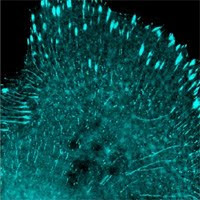AlleleBlog: Published
online by Nature Biotechnology, researchers from Ken Chien’s lab at
Harvard and other coauthors showed that modified mRNA of VEGF-A injected
intramyocardially resulted in the expansion and directed
differentiation of endogenous heart progenitors. VEGF-A modRNA markedly
improved heart function and enhanced long-term survival of recipients
by directing epicardial progenitor cells toward cardiovascular cell
types. This publication appears to be the first example of using mRNA
as a delivery platform for cell fate-related therapy. AstraZeneca
recently invested $240 million on mRNA-related delivery via Moderna, a
company with roots within the Harvard stem cell group.
The
drastically increased efficacy of using the mRNA platform was
accredited to the pulse-like kinetics of mRNA expression profile. It
was explained by the fact that native paracrine signals are often
transient and precisely regulated in time and space, therefore the
pulse-like expression profile of modRNA might be well suited to
delivering paracrine-factor signals. Transfected mRNA molecules do not
need to penetrate the nuclear membrane, which greatly enhances the
efficiency of protein expression on a per transfected molecule over DNA.
mRNAs turn over in a much faster pace than plasmid-mediated transgene
expression. This is beneficial to many cell fate decisions as
exemplified by this recent publication.
Allele Biotech’s reprogramming technologies, licensed by some of the leading stem cell therapy companies, are built around the mRNA platform.
We chose mRNA as our core technology to not only change cell fate, but
also direct differentiation. We know this platform is the future for
cell fate manipulation because we have seen how robustly mRNA expression
made the day-and-night difference in gene expression when compared to
plasmid DNA (episomal or not), retrovirus, lentivirus, baculo virus, or
even transfected proteins. We could convert human fibroblasts into
iPSCs, in bulk, in as short as one week with no more effort than
changing mRNA complex-containing medium.
Another recent development in iPSC research is in situ reprogramming. Abad et al.
generated mice carrying a Tet-inducible cassette of the four
cell-reprogramming factors. They then added feed doxycycline to the
animals. After several weeks, teratomas appeared in various tissues,
indicating that in situ reprogramming had occurred. The iPSCs created this way did not appear to have much advantage over in vitro
produced iPSCs other than they are totipotent (helpful if you are
studying placenta). Nevertheless, the concept of changing cell fate in situ
as dramatically as complete reprogramming is an important leap of
faith. As for the next big step, it is easy to see that mRNAs are well
suited for in situ reprogramming, as well as
transdifferentiation, and more complex gene delivery than the above
mentioned VEGF-A alone in heart treatment.
References:
Zangi et al. Nature Biotechnology, http://www.nature.com/nbt/journal/vaop/ncurrent/abs/nbt.2682.html
Abad et al. Nature, http://www.nature.com/nature/journal/vaop/ncurrent/abs/nature12586.html
Zangi et al. Nature Biotechnology, http://www.nature.com/nbt/journal/vaop/ncurrent/abs/nbt.2682.html
Abad et al. Nature, http://www.nature.com/nature/journal/vaop/ncurrent/abs/nature12586.html



